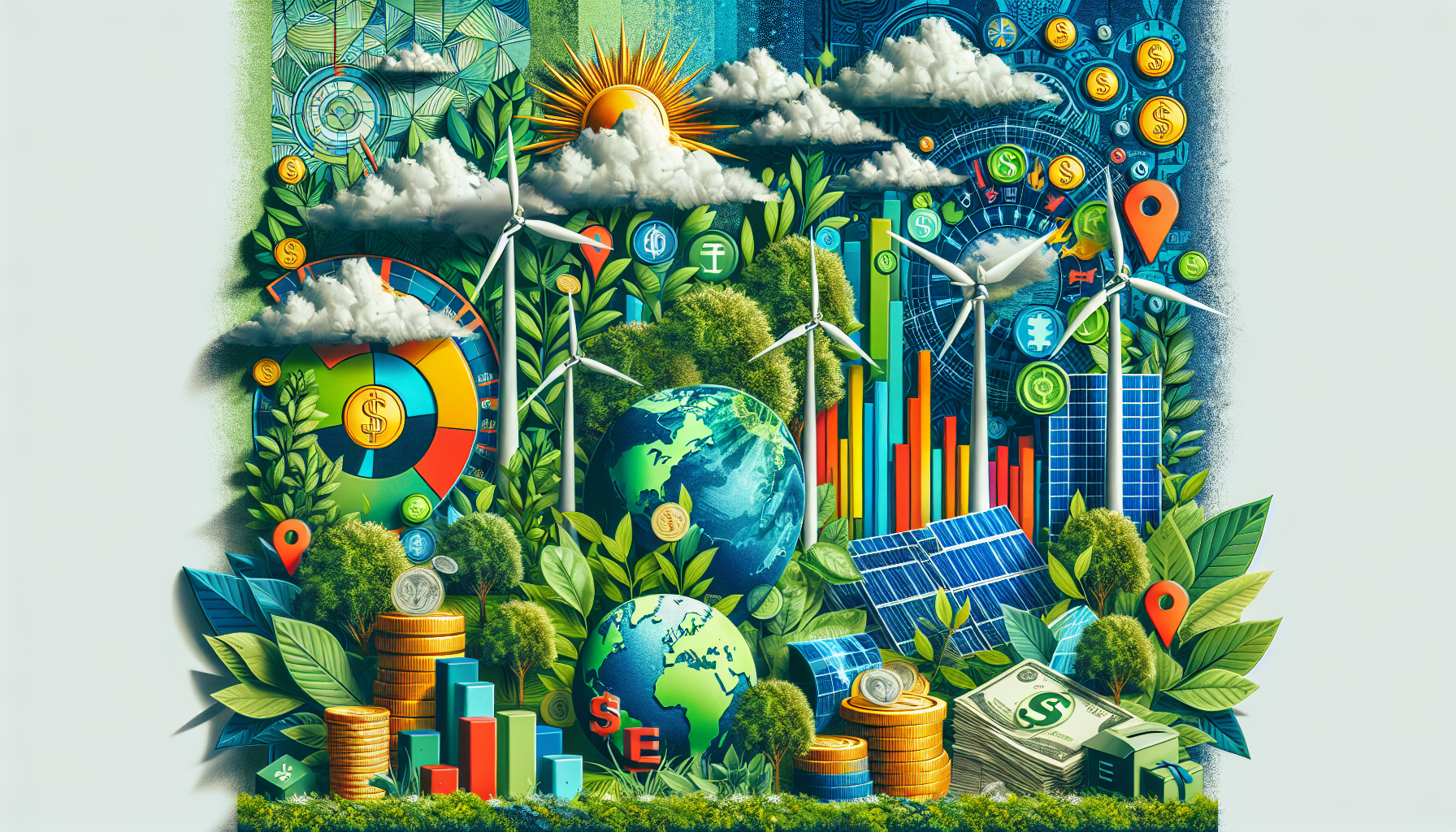The Power of Green: Unlocking Sustainable Finance Trends and Prospects

Understanding Sustainable Finance
Sustainable finance represents a transformative approach where financial services integrate environmental, social, and governance (ESG) criteria into business and investment decisions. This sector encompasses a range of activities designed to promote environmentally sustainable investments, with the dual goal of achieving positive returns and long-term impact on society, the environment, and the overall governance of corporations.
Growth of Sustainable Investments
The domain of sustainable and green finance has witnessed a significant uptick in activity, with sustainable investments regaining momentum and poised for further growth in 2023 ScaleX Invest. Despite a slowdown in 2022, the trends indicate a resilient and expanding interest in investments that support environmental and social objectives.
Millennials, in particular, have been pivotal in driving this growth, with a notable 95% expressing interest in sustainable investments and 70% believing that their investment choices can influence climate change ScaleX Invest. This generational shift reflects a broader understanding of the relationship between financial markets and the health of our planet, and the role that individual and institutional investments can play in fostering positive change.
Key Sectors in Green Financing
Green financing is gaining traction across several key sectors, fueled by the recognition of the financial sector’s impact on climate change. Large financial institutions have been instrumental in funding industries that have significant environmental implications, such as the global plastics supply chain and fossil fuels ScaleX Invest. This has prompted a surge in demand for financing options that prioritize sustainability and environmental stewardship.
Among the sectors drawing substantial attention for green financing are:
- Renewable energy (solar, wind, hydroelectric)
- Sustainable agriculture and forestry
- Energy-efficient technologies and buildings
- Waste management and recycling
- Clean transportation (electric vehicles, public transit systems)
- Water conservation and management
The rapid growth of the sustainable and green finance sector, boasting a compound annual growth rate of 77% from 2015 to 2019, underscores the increasing commitment to funding these critical areas Emeritus. This commitment is essential for meeting the ambitious climate targets set forth in international agreements like the Paris Accord.
As sustainable finance continues to evolve, it is poised to play a central role in shaping the future of the financial markets, influencing everything from the digital transformation of financial markets to the future of stock exchanges and trading platforms. The integration of sustainability into financial decision-making is not only a moral imperative but also a strategic one, as it seeks to align investors’ portfolios with a future that is both financially and ecologically resilient.
Trends in Sustainable Finance
The landscape of finance is undergoing a significant transformation as sustainable and green finance continues to gain momentum. This section will explore how millennial investors are shaping the market and the performance of investments that prioritize environmental, social, and governance (ESG) criteria.
Millennial Influence on Investments
Millennials have emerged as a powerful demographic in the world of finance, particularly within the realm of sustainable investments. A staggering 95% of millennials have shown a keen interest in putting their money into investments that align with their values and consider the long-term impact on society and the environment (ScaleX Invest). Furthermore, a significant portion of the population, 70% to be exact, believes that their investment choices have the potential to create meaningful change, particularly in combating climate change.
The influence of millennials extends beyond their investment preferences, as they are also likely to support companies and brands that are transparent about their sustainability efforts. This shift in investor sentiment is pushing the market towards a more sustainable future and is a clear indication of the changing priorities among younger investors. For more on how generational changes are impacting financial markets, read about the digital transformation of financial markets.
ESG Performance and Returns
Investments that adhere to ESG criteria have not only become increasingly popular but have also shown strong performance over recent years. In 2020, ESG funds often provided excess returns compared to their traditional counterparts. Specifically, 55% of impact investment opportunities have resulted in competitive, market-rate returns, dispelling the myth that sustainable investments come at the cost of profitability (ScaleX Invest).
| Year | ESG Investment Returns | Traditional Investment Returns |
|---|---|---|
| 2020 | +6.9% | +6.3% |
This data underscores the fact that sustainable and green finance is not only about ethical considerations but also about savvy investing. The trend towards ESG-focused investments is driven by the desire to mitigate risks associated with climate change and societal challenges while responding to consumer demands for more responsible business practices. The continued growth in ESG investments is a testament to their resilience and the recognition that these strategies can lead to long-term, sustainable economic growth.
For more insights into the performance of ESG investments and their impact on the financial markets, readers may explore trends in consumer banking and digital payments and the role of big data and analytics in financial decision-making.
Overall, the trends in sustainable finance reflect a broader shift in the investment landscape. As investors become more conscious of the social and environmental implications of their financial decisions, the market is adapting to meet these new preferences with an array of innovative products and strategies that prioritize sustainability alongside financial returns.
Regulatory and Reporting Frameworks
As sustainable and green finance continue to gain prominence, it’s crucial to have strong regulatory and reporting frameworks in place. These frameworks ensure that investments are genuinely contributing to environmental sustainability and social responsibility. Two major developments in this area are the EU Sustainable Finance Taxonomy and the Task Force on Climate-related Financial Disclosures (TCFD).
EU Sustainable Finance Taxonomy
The EU Sustainable Finance Taxonomy is a classification system established by the European Union to guide investors and companies in navigating the transition to a sustainable economy. It sets out criteria for determining whether an economic activity is environmentally sustainable, providing a common language and clear definitions International Business Magazine. This initiative is part of the broader Action Plan on Financing Sustainable Growth, reflecting the EU’s dedication to embedding sustainability within the financial sector Norton Rose Fulbright.
The Taxonomy encourages banks and other financial institutions to incorporate sustainable practices into their operations and investment strategies, ensuring that their activities support environmentally sound projects.
| Categories | Description |
|---|---|
| Climate Change Mitigation | Activities that contribute to reducing greenhouse gas emissions |
| Climate Change Adaptation | Activities that focus on adapting to the impacts of climate change |
| Sustainable Use and Protection of Water and Marine Resources | Activities that protect water and marine environments |
| Transition to a Circular Economy | Activities that support resource efficiency and recycling |
| Pollution Prevention and Control | Activities that aim to prevent or reduce pollution |
| Protection and Restoration of Biodiversity and Ecosystems | Activities that preserve natural habitats and biodiversity |
TCFD and Financial Disclosures
The Financial Stability Board established the Task Force on Climate-related Financial Disclosures to provide a framework for companies and financial institutions to report on climate-related financial risks and opportunities. The TCFD’s recommendations are designed to help organizations improve their understanding and disclosure of climate-related impacts within four key areas: governance, strategy, risk management, and metrics and targets Norton Rose Fulbright.
The TCFD framework is gaining traction globally, with many companies beginning to incorporate its guidelines into their reporting practices. This ensures greater transparency for investors and stakeholders and promotes the integration of climate considerations into business and financial decisions.
In addition to the TCFD, the EU has introduced the Corporate Sustainability Reporting Directive (CSRD), which mandates large companies to publish detailed reports on their environmental and social impact. This legislation aims to provide stakeholders with the necessary information to assess a company’s non-financial performance Plan A Earth.
Furthermore, the UK has developed the Disclosure Framework for Net Zero Transition Plans to support companies in reporting their progress toward net zero emissions, reinforcing the UK’s ambition to lead in aligning its financial center with net zero targets Plan A Earth.
These regulatory and reporting frameworks are crucial components in the advancing landscape of sustainable and green finance. They provide the structure and transparency needed to foster accountability and facilitate informed decision-making by investors and stakeholders. As these frameworks evolve, they will play a significant role in shaping the future of financial markets, emerging technologies such as blockchain and AI, and the overall economic growth driven by sustainable development.
Global Developments in Green Finance
The global financial landscape is witnessing a substantial shift towards sustainability, with green finance playing a pivotal role in this transformation. This section explores the rapid expansion of the green bond market and the surge of sustainable finance in the Asia-Pacific region.
Green Bond Market Expansion
The green bond market has seen a remarkable uptick in recent years, as evidenced by the increase in issuance from a modest $3 billion in 2012 to a staggering nearly $300 billion in 2020. This surge is a testament to the rising appetite among investors for environmentally conscious investment vehicles IMF.
| Year | Global Green Bond Issuance |
|---|---|
| 2012 | $3 billion |
| 2015 | $42 billion |
| 2019 | $324 billion |
| 2020 | $300 billion (approx.) |
The compound annual growth rate of the sustainable and green finance sector stood at 77% from 2015 to 2019, demonstrating the sector’s robust expansion and the increasing integration of ESG (Environmental, Social, and Governance) criteria into financial decision-making Emeritus.
Europe has maintained its position as the largest issuer, contributing to 45% of the total green bond volume in 2019, further cementing its status as an influential player in the green finance arena 4irelabs. Meanwhile, the United States and France follow suit, with China leading the way in terms of individual country issuance, reflecting a worldwide commitment to sustainable finance.
Asia-Pacific’s Sustainable Finance Surge
The Asia-Pacific region, with the exception of China, has emerged as the fastest-growing market for green bonds, accounting for 24% of the global issuance in 2019. This significant development underscores the region’s dedication to adopting sustainable finance practices 4irelabs.
The region’s commitment to green finance is not only a response to the global call for action on climate change but also a strategic economic move. By investing in sustainable projects, the Asia-Pacific countries are positioning themselves at the forefront of the green revolution, which promises to be a driver of future economic growth.
The number of green bonds issued globally also reflects the burgeoning market, with a substantial increase from 106 in 2015 to 1,606 in 2019. This escalation indicates the strengthening momentum behind green finance and the broadening appeal of sustainable investments among global investors.
| Region | Share of 2019 Global Green Bond Issuance |
|---|---|
| Europe | 45% |
| Asia-Pacific | 24% (excluding China) |
| China | Leading individual country issuer |
These global developments in green finance are intricately linked with other emerging trends and innovations in the financial markets, such as the rise of decentralized finance (DeFi) and the growing importance of cybersecurity. As sustainable and green finance continues to evolve, it becomes an essential component of the broader discourse around the future of financial markets and the impact of climate change on investments, shaping the trajectory of global economic development.
Future of Sustainable and Green Finance
The future of sustainable and green finance is a dynamic field with evolving challenges and opportunities, shaped by policy and regulatory impacts. This section examines these elements and their influence on the trajectory of sustainable finance.
Challenges and Opportunities
Sustainable and green finance faces a range of challenges and opportunities as it becomes more integrated into the broader financial landscape. On one hand, the growing awareness of sustainability’s role in a resilient financial system is leading to increased investment and innovation. However, challenges such as the need for standardized reporting, the complexity of measuring impact, and the potential for greenwashing remain.
The convergence of international actions on sustainable development and climate change is creating opportunities for financial institutions to manage and report Environmental, Social, and Governance (ESG)-related risks and opportunities more effectively. As voluntary measures become more common, there is an increasing likelihood of regulatory intervention, which could lead to mandatory audits and changes in risk management practices, as noted by Norton Rose Fulbright.
Additionally, the COVID-19 pandemic has highlighted the significance of sustainable finance in building resilience against systemic risks. This has opened up opportunities for sustainable investments to support a green and inclusive recovery, as emphasized by the International Monetary Fund (IMF).
Policy and Regulation Impact
Policy and regulation play a pivotal role in shaping the future of sustainable and green finance. Policymakers are encouraged to create a supportive regulatory environment to foster sustainable finance practices, including implementing disclosure requirements and providing incentives for green investments. Effective regulation can address market failures and ensure the stability of sustainable finance initiatives in the long term, as suggested by the IMF.
The European Commission’s adoption of an Action Plan on Financing Sustainable Growth and the establishment of the Task Force on Climate-related Financial Disclosure (TCFD) by the Financial Stability Board are prominent examples of policy initiatives aimed at integrating sustainable finance principles into financial systems and improving disclosure and risk management practices, respectively. These initiatives are detailed by Norton Rose Fulbright.
For investors who are new to the financial markets, understanding these policy and regulatory frameworks is crucial. It not only helps them align their investments with sustainable practices but also prepares them for the evolving landscape of global finance, which includes emerging topics such as the future of cryptocurrency in global finance, the rise of decentralized finance (DeFi), fintech innovations, and the impact of climate change on financial markets and investments.
The forward momentum of sustainable and green finance is evident, but its trajectory will be significantly influenced by the ongoing development and enforcement of policies and regulations aimed at promoting ethical, responsible, and environmentally-conscious investing.
Sustainable Finance and Economic Growth
The integration of sustainable and green finance is not only reshaping investment portfolios but also fueling economic growth and job creation. Exploring this facet of finance reveals the tangible impact that environmentally conscious investments have on the broader economy.
Job Creation and Economic Benefits
Sustainable finance is a powerful catalyst for employment. The move toward greener economies opens up new sectors and expands existing ones, from renewable energy to sustainable agriculture, creating a demand for a wide range of jobs. According to Emeritus, the green finance industry is poised to drive the transition to a sustainable future, fostering economic growth and generating employment opportunities globally.
The economic benefits of sustainable finance extend beyond job creation. Investments in green projects often lead to the development of new technologies and innovations, which can enhance productivity and efficiency across industries. This, in turn, can stimulate further economic activity and provide a competitive edge in the global market.
| Sector | Potential Job Growth |
|---|---|
| Renewable Energy | High |
| Sustainable Agriculture | Moderate |
| Green Construction | Significant |
| Environmental Conservation | Steady |
Investing in sectors that prioritize sustainability not only contributes to a healthier planet but also promotes economic stability and growth.
Investing in a Low-Carbon Future
The shift towards low-carbon and green technologies is a key component of sustainable finance. As investors recognize the long-term benefits and necessity of minimizing carbon footprints, capital is increasingly directed towards projects that support a low-carbon future. This includes the development of renewable energy sources, energy-efficient infrastructure, and technologies that reduce emissions.
Investing in such initiatives is not only environmentally responsible but also economically prudent. As the world moves away from fossil fuels, the demand for alternative energy solutions rises, presenting opportunities for growth and innovation in the sector. Sustainable finance acts as a conduit for these investments, aligning financial goals with environmental objectives.
To further explore how financial markets are adapting to these changes, readers can delve into topics like the digital transformation of financial markets, the rise of decentralized finance (defi) and its implications, and impact of climate change on financial markets and investments.
The intersection of finance and environmental sustainability is not just a trend but a necessary evolution of the investment landscape, one that promises both economic benefits and a healthier planet. As sustainable and green finance continues to grow, so too will its role in shaping a resilient and prosperous economic future.
The Role of Banks and Investors
The financial institutions and investment community are at the forefront of shaping the sustainable and green finance landscape. Their roles extend from aligning investments with responsible practices to pioneering innovative finance products that support environmental and social governance (ESG) criteria.
Aligning Investments with ESG Criteria
Banks are increasingly incorporating ESG criteria into their investment decisions. This process involves a rigorous assessment of the environmental impact, social responsibility, and governance structure of potential investments. By prioritizing ESG criteria, banks are supporting sustainable projects across various sectors, including renewable energy, clean technology, and green infrastructure. The shift towards sustainable practices is not just an ethical choice but also a strategic business move, as it opens up new opportunities for growth and positions banks as leaders in the transition to a greener economy International Business Magazine.
In the context of global finance, this alignment has broader implications, influencing the digital transformation of financial markets, the future of cryptocurrency, and emerging technologies such as blockchain and AI.
Innovative Sustainable Finance Products
To meet the growing consumer and investor demand for green finance options, financial institutions are developing an array of innovative sustainable finance products. These include green loans, sustainability-linked bonds, and impact investing strategies, which are designed to provide financial returns while also contributing to positive environmental and social outcomes.
| Sustainable Finance Product | Description |
|---|---|
| Green Loans | Loans specifically earmarked for funding eco-friendly projects |
| Sustainability-Linked Bonds | Bonds tied to the issuer’s achievement of predetermined sustainability objectives |
| Impact Investing Strategies | Investment approaches focusing on generating measurable environmental and social impact alongside financial returns |
These inventive financial instruments are pivotal in driving continued growth in the sustainable finance sector and fostering transformative changes in the global financial landscape. They also offer investors a way to contribute to a low-carbon future while potentially benefiting from the economic growth linked to sustainability.
As banks and investors evolve, they are playing an instrumental role in not only the financial markets but also in addressing broader societal challenges. By aligning their investments with ESG criteria and creating innovative sustainable finance products, they are leading the charge towards a more sustainable and resilient global economy.





